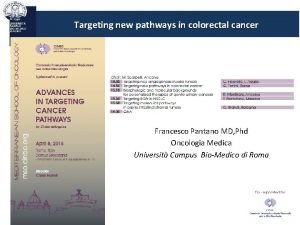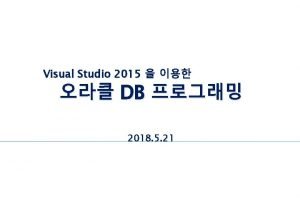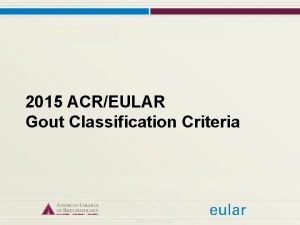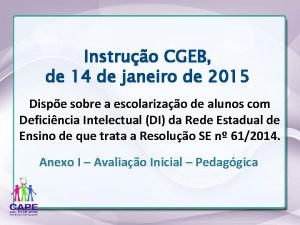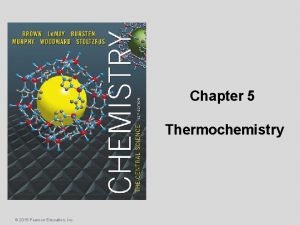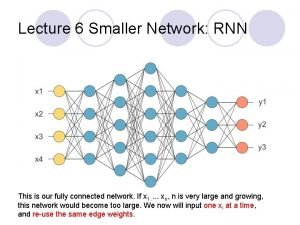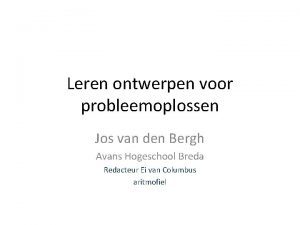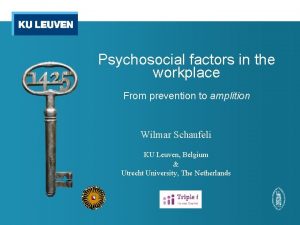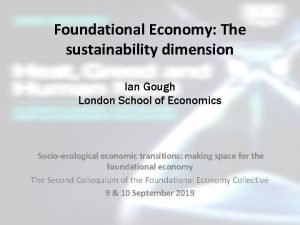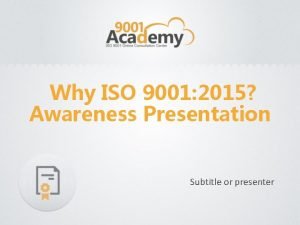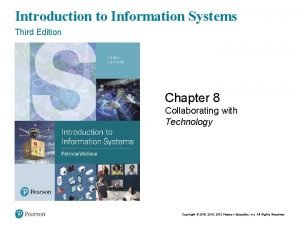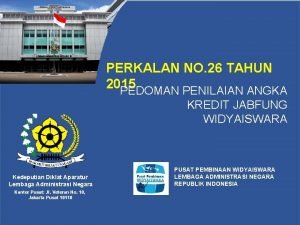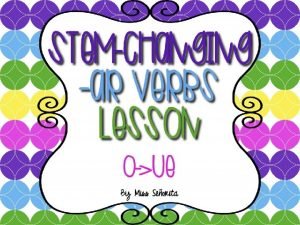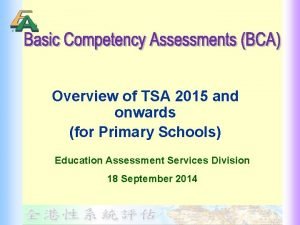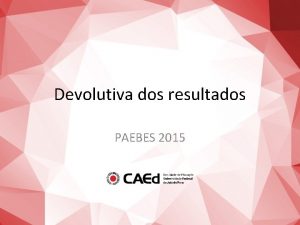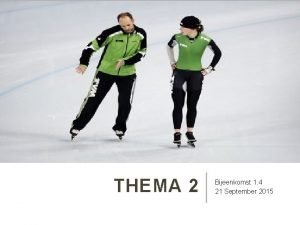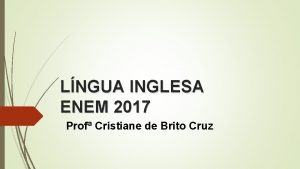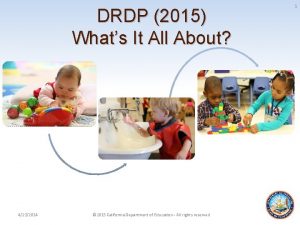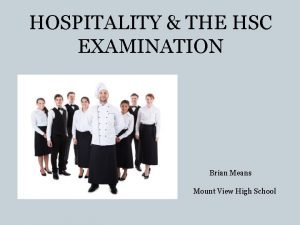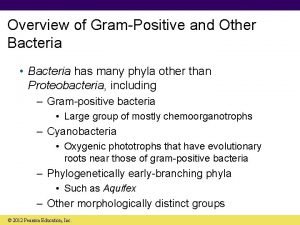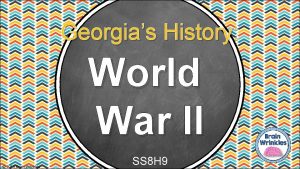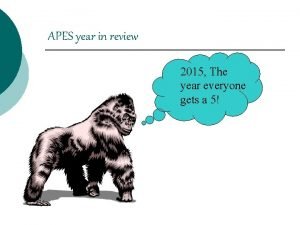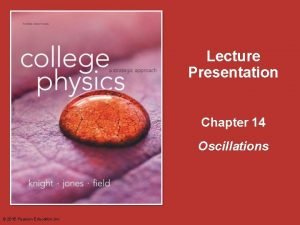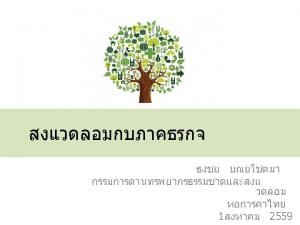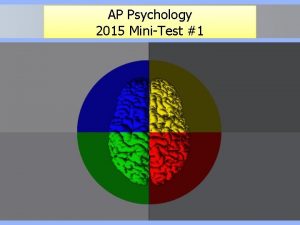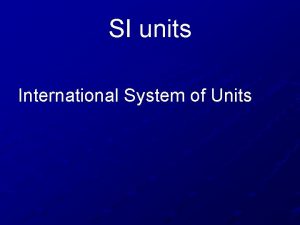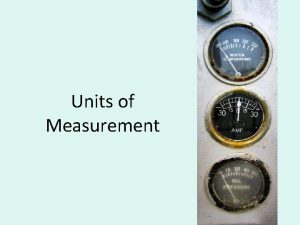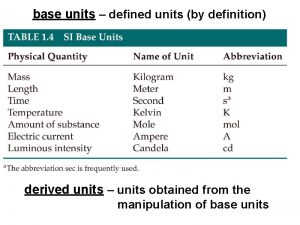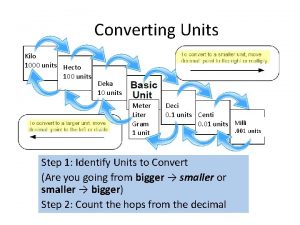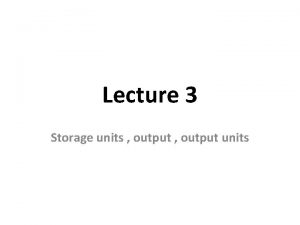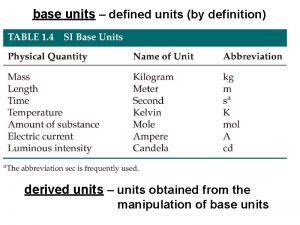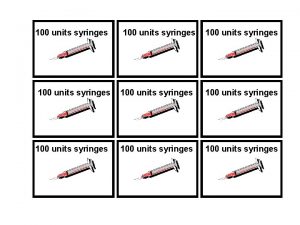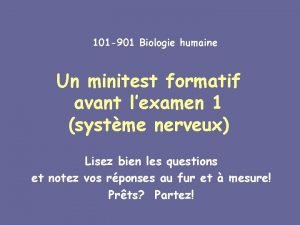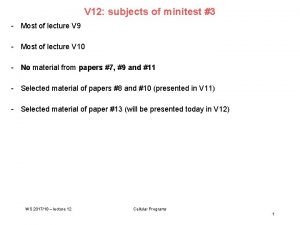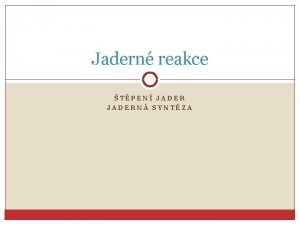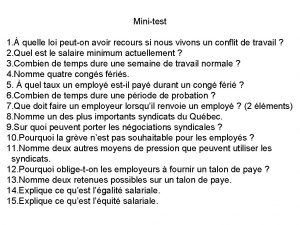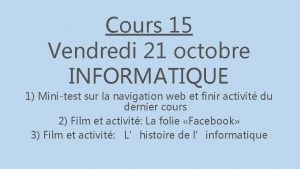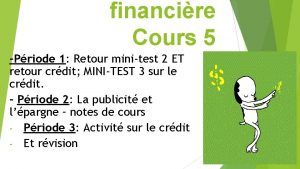AP Psychology 2015 MiniTest 3 Units 7 8



























































- Slides: 59

AP Psychology 2015 Mini-Test #3 Units #7, 8 & 9

Mini Test #3 Entire KEY

#1. When asked which of two countries has a larger population, participants are likely to judge the country that is more familiar to them as being more populous. Which of the following best explains this finding? A. A means-end analysis B. The representativeness heuristic C. The availability heuristic D. Algorithms E. Inductive reasoning

1. C - Availability Heuristic § • Although diseases kill many more people than accidents, people will judge accidents and diseases to be equally fatal. • This is because accidents are more dramatic and are often written up in the paper or seen on the news on t. v. , and are more available in memory than diseases. Estimating the likelihood of events based on their availability in our memory. • If it comes to mind easily (maybe a vivid event) we presume it is common.

#2. The psychoanalytic concept of repression suggests a difficulty in the functioning of which aspect of memory? A. Encoding B. Short-term memory C. Procedural memory D. Explicit memory E. Retrieval

2. E § § Repression means to keep something down in your unconscious mind (like a horrible car crash) Retrieval is getting something out of your LT memory. A. Encoding – getting it “in” B. Short-term memory - Working memory, the new name for short-term memory, has a limited capacity (7± 2) and a short duration (20 seconds). C. Procedural memory - memories that relate to skills or habits, Examples the memory of how to brush your teeth or ride your bike D. Explicit memory (declarative) - refers to facts and experiences that one can consciously know and declare. Ex: The capital of IL is Springfield; 2+ 2+=4. (Easy to Explain)

#3. Which psychologist reported that infant attachment to another goes beyond the satisfaction of the need for nourishment? A. Albert Bandura B. Jean Piaget C. Harry Harlow D. Erikson E. Konrad Lorenz

3. § C. Harry Harlow A. Albert Bandura – Bobo Doll & Observational Learning B. Jean Piaget - Stages of Cognitive Dev. C. Harry Harlow - attachment D. Erikson - Stages E. Konrad Lorenz - imprinting

Piaget’s Theory and Current Thinking Some Puppies Chew Furniture! 9

1 0

#4. When trying to solve a problem, Bret uses a logical, step-by-step formula called: A. A heuristic B. Incubation C. Insight D. Priming E. An algorithm

4. E -Guess my phone number using an algorithm. § § § 000 -0000 000 -0001 000 -0002 000 -0003 000 -0004 Algorithms are slow, but eventually accurate. Computers use algorithms. § Heuristics are mental short cuts. Using a heuristic, you might start with my area code.

A. A heuristic - Heuristics are simple, thinking strategies that allow us to make judgments and solve problems efficiently. Heuristics are less time consuming, but more error-prone than algorithms. ; You wouldn’t go to the juice aisle to look for lettuce B. Incubation – “Incubation Effect” Coming to a solution when you are not consciously working on the problem. C. Insight - Insight involves a sudden novel realization of a solution to a problem. Humans and animals have insight. D. Priming - To retrieve a specific memory from the web of associations, you must first activate one of the strands that leads to it.

#5. It is well established that certain autonomic responses such as heart rate, perspiration, and respiration change under stress. In view of the fact that people generally have stronger autonomic responses when lying than when telling the truth, it follows that the polygraph would be a foolproof approach to lie detection. Which statement best explains why the polygraph is not more widely used in courtrooms and in testing of job applicants? A. B. Most people can avoid detection when they lie. Physiological arousal is much the same for several emotions, so the polygraph cannot always reliably distinguish guilt from other reactions. C. A significant number of people show paradoxical autonomic reactions, responding more strongly when telling the truth than when lying. D. In controlled studies, the polygraph has correctly identified guilty individuals in only a small percentage of cases. E. The polygraph has been shown to be reliable only in highly emotional cases, such as child abuse and spying.

5. B § The answer is B. § Polygraphs only measure anxiety but they can’t tell you why someone is anxious.

#6. Chuck recalls the day last summer when he fell off his bicycle and scraped his knee. This is an example of: A. Iconic memory B. Procedural memory C. Semantic memory D. Episodic memory E. Short-term memory

6. D Episodic memory – episodes of your life A. Iconic memory – visual stimuli B. Procedural memory - memories that relate to skills or habits, Examples the memory of how to brush your teeth or ride your bike C. Semantic memory - Semantic: memories of general, factual knowledge Examples state capitals, math facts, or historic events D. Episodic memory - memories from personally experienced events ; What you did on your 16 th birthday E. Short-term memory - Working memory, the new name for short-term memory, has a limited capacity (7± 2) and a short duration (20 seconds).


#7. Researcher Renee Baillargeon found that fourmonth-old infants will look longer at a ball if it appears to roll through a solid barrier, demonstrating that babies seem to grasp basic physical laws intuitively. Which of the following theories does this finding challenge? A. Lawrence Kohlberg’s theory of moral development B. Lev Vygotsky’s social cognition theory C. Jean Piaget’s theory of cognitive development D. Mary Ainsworth’s findings from the Strange Situation E. Erikson’s theory of psychosocial development

7. C § Jean Piaget said infants have not mastered conservation of mass. However, the question discounts Piaget’s findings. § D. Ainsworth studied attachment, not cognition.

Kohlberg’s Theory of Moral Development LEVEL STAGE Stage 1 1. Preconventional Stage 2 Stage 3 STAGE NAME Punishment. Obedience Personal Reward MORAL REASONING Obey rules to avoid punishment Conforms to receive rewards Good Boy. Nice Girl Gain approval/avoid disapproval Law & Order Conform to authority to avoid guilt/dutiful citizen Social Contract/Concern for individual rights/obey society’s rules for mutual benefit 2. Conventional Stage 4 Stage 5 3. Postconventional Stage 6 Universal Ethics Principle Universal Principles: What would a nun do? /guided by conscience/reflective EXAMPLE One middle school teacher devised the most effective strategy for getting students to class on time. He has latecomers do pushups--50 of them--in front of the class A fourth grade girl refrains from running in the hallway to avoid the consequences involved in breaking that school's rule. A middle school student refrains from arguing with her classmate so she is able to participate in group work later in the period. A student offers to be last in line when going to the cafeteria so she can be first in line when going out for recess. A middle school student agrees to throw out the gum she is chewing to please the teacher. In an inner city high school student's journal, she wrote "I am going to work harder in school so I won't let you down because if you think I can make it then I can make it" "It is compulsory for all school-age students to attend school. " "Gang activity must be off school premises. " School officials have both the legal authority and the professional responsibility to deny student rights that seriously disrupt student learning activities A combined first and second grade class makes its own rules during the first month of the year according to a class meeting where students discuss what is proper and improper behavior in the classroom and why a particular behavior is inappropriate (ie. , who is affected by your actions) A combined first and second grade class makes its own rules during the first month of the year according to a class meeting in which all students are asked to reflect on what is right and wrong and why things are right and wrong. At a high school for girls in Chicago, math classes studied demographic facts related to hunger , and religion classes discussed the question of "What is our ethical and religious responsibility for the starving people of the world?

Piaget Alterative – Lev VYGOTSKY Russian Psychologist who suggested that children develop cognitively more by SOCIAL INTERACTION – especially with teachers rather than with objects as Piaget suggested. Social interaction with teachers took the form of SCAFFOLDING during which teacher gives the learner more HELP at the beginning of a learning process then begins to withdraw help as the learners skills improve 22

#8. During a psychology experiment, a researcher uses a probe to lesion the ventromedial nucleus of a rat’s hypothalamus. After the procedure the rat will most likely A. Become less aggressive B. Become more aggressive C. Eat more and gain weight D. Stop eating and lose weight E. Experience a loss of coordination and muscular control

8. C Lateral Hypothalamus § When stimulated it makes you hungry. § When lesioned (destroyed) you will never be hungry again. LH = LARGE HUNGER If stimulate the lat, you’ll get fat!! Ventromedial Hypothalamus § § When stimulated you feel full. When lesioned you will never feel full again. VMH = VERY MINUTE (small) HUNGER (Vacate My Hunger) “off” switch -- If stimulate the ven, you’ll get thin!

#9. A basic assumption underlying short-term memory is that it is: A. Limited in capacity B. Unlimited in capacity C. Long-lasting D. Not under conscious control E. Resistant to decay

9. A Short-term memory Working memory, the new name for short-term memory, has a limited capacity (7± 2) and a short duration (20 seconds).

#10. Carol Gilligan, in her criticism of Lawrence Kohlberg, proposed that the moral reasoning of males is primarily based on: A. Male repression of females, whereas the moral reasoning of females is based on economics B. Rational abstract principles, whereas the moral reasoning of females is based on relationships and the social context C. Legalistic ideals, whereas the moral reasoning of females is based on more humanistic ideals D. Observational learning, whereas the moral reasoning of females is genetically determined for the most part E. Physical strength, whereas males start developing morally later than females but surpass them soon afterward

§ § § 10. B Gilligan would go on to criticize Kohlberg's work. Kohlberg only studied privileged, white men and boys. She felt that this caused a biased opinion against women. Secondly, in his stage theory of moral development, the male view of individual rights and rules was considered a higher stage than women's point of view of development in terms of its caring effect on human relationships. Her criticisms were published in 1982 in her most famous book titled, In a Different Voice: Psychological Theory and Women's Development. She came to be known as the founder of "difference feminism". Many feminists insisted that there are no differences between males and females. Gilligan asserted that women have differing moral and psychological tendencies than men. According to Gilligan, men think in terms of rules and justice and women are more inclined to think in terms of caring and relationships. She asks that Western society begin to value both equally

#11. Which process transfers information from sensory memory to short-term memory? A. Attention B. Cognition C. Differentiation D. Perception E. Sensation

11. A § § The answer is attention. If you don’t pay attention, then all you hear is blah.

#12. If Juan tried to learn a long list of words, he would most likely forget the words that: A. Appeared early in the list B. Appeared near the end of the list C. Appeared in the middle of the list D. Were very unlike the rest of the words E. Were randomly dispersed throughout the list

§ 12. C The serial positioning effect says we remember the first and last items of a list best. Percentage of words recalled 90 80 70 60 50 40 30 20 10 0 1 2 3 4 5 6 7 8 Position of word in list 9 10 11 12

#13. Although he finds it difficult and not much fun, Tomas puts in long hours practicing field hockey in the hope of getting an athletic scholarship to college. This best illustrates the idea of: A. Homeostasis B. Attribution theory C. Catharsis D. Extrinsic motivation E. Arousal theory

§ 13. D Since he’s only doing it for some “outside” reward like money, he’s extrinsically motivated. If he did it for the love of the game, that would be intrinsic motivation. Homeostasis - Maintenance of a steady internal state; Biological Homeostasis: physical conditions; Hunger, thirst, body temperature; Cognitive Homeostasis: mental conditions; Consistency, balance, harmony in one’s thinking Attribution theory - deals with how the social perceiver uses information to arrive at causal explanations for events. It examines what information is gathered and how it is combined to form a causal judgment” Catharsis - A catharsis is an emotional release. According to psychoanalytic theory, this emotional release is linked to a need to release unconscious conflicts. For example, experiencing stress over a work-related situation may cause feelings of frustration and tension. Rather than vent these feelings inappropriately, the individual may instead release these feelings in another way, such as through physical activity or another stress relieving activity. Extrinsic motivation - refers to behavior that is driven by external rewards such as money, fame, grades, and praise. This type of motivation arises from outside the individual, as opposed to intrinsic motivation, which originates inside of the individual. Arousal theory - The arousal theory of motivation suggests that people are driven to perform actions in order to maintain an optimum level of physiological arousal.

#14. Of the following cognitive milestones which ability tends to be acquired last? A. Telegraphic speech B. Use of schemas C. Object permanence D. Hypothetical thinking E. Assimilation

§ 14. D Just pick the most advanced sounding. Telegraphic speech - Telegraphic speech is the type of speech produced by people who have suffered injury to a part of the brain called Broca’s area. Telegraphic speech consists of sentences spoken with an abnormal rhythm. While people with telegraphic speech speak in meaningful but simple sentences, they omit important grammatical components from most sentences. Use of schemas - Piaget's theory, a schema is both the category of knowledge as well as the process of acquiring that knowledge. As experiences happen and new information is presented, new schemas are developed and old schemas are changed or modified. Object permanence - describe a child's ability to know that objects continue to exist even though they can no longer be seen or heard. Assimilation - The process of assimilation involves incorporating new experiences into our current understanding (schema). The process of adjusting a schema and modifying it is called accommodation.

#15. Paul Ekman found that when Japanese students watched films of surgery, they masked their expressions of disgust with a smile when an authority figure entered the room but not when alone. American students maintained their expressions of disgust both alone and in the presence of an authority figure. Ekman’s findings illustrate what he calls: A. The facial feedback hypothesis B. Display rules C. Phlegmatic personalities D. The two-factor theory E. Adaptation-level phenomenon

§ 15. B Although Ekman found that there are 6 facial expressions that are universal around the world, the rules for displaying those expressions differ from culture to culture. The facial feedback hypothesis - The idea that one’s facial expressions can have an effect on emotional experience. Example: A woman attending a stuffy party forces herself to smile, and finds she feels happier as a result. Display rules - Cultural rules dictating whether and how to express one’s emotions in a certain situation. Example: When the boss’s annoying favorite assistant fell on his face during the office talent show, everyone found it hilarious but few dared to laugh. Phlegmatic personalities - Four temperaments is a proto-psychological theory that suggests that there are four fundamental personality types, sanguine (pleasureseeking and sociable), choleric (ambitious and leader-like), melancholic(analytical and quiet), and phlegmatic (relaxed and peaceful). Most formulations include the possibility of mixtures of the types. A. The two-factor theory B. Adaptation-level phenomenon

Two-Factor Theory Stanley Schachter and Jerome Singer proposed yet another theory which suggests our physiology and cognitions create emotions. Emotions have two factors– physical arousal and cognitive label. Ex: On a date with your crush get sweaty palms you tell yourself “Hmm…I must be nervous” You FEEL fear/anxiety b/c you labeled your physiological experience 39

#16. Which of the following theories suggests that a physiological need creates a state of tension that motivates an organism to satisfy the need? A. Opponent-process B. Drive-reduction C. Incentive D. Arousal E. Gate-control

§ 16. B Think of a drive like hunger. Just before you eat, you feel a tension. Then you satisfy that need. Opponent-process: Opponent-process theory suggests that color perception is controlled by the activity of two opponent systems; a blue-yellow mechanism and a red-green mechanism. Drive-reduction: When the instinct theory of motivation failed, it was replaced by the drive-reduction theory. Drive-Reduction (Clark Hull, psychologist) A physiological need creates an aroused tension state (a drive) that motivates an organism to satisfy the need. Incentive: - here a many different reasons why we do things. Sometimes we are motivated to act because of internal desires and wishes, but at other times our behaviors are driven by a desire for external rewards. The incentive theory is one of the major theories of motivation and suggests that behavior is motivated by a desire for reinforcement or incentives. Arousal: The arousal theory of motivation suggests that people are driven to perform actions in order to maintain an optimum level of physiological arousal. What exactly is the optimal level of motivation? Well, it varies from one individual to the next. Gate-Control Theory-Melzack and Wall (1965, 1983) proposed that our spinal cord contains neurological “gates” that either block pain (block pain) or allow it to be sensed (small fibers, open). Rub the area around your stubbed toe and its a competing stimulation and will block (large fibers) some pain messages.

#17. According to Jean Piaget, children cease to exhibit egocentrism during which of the following stages? A. Sensorimotor B. Preoperational C. Concrete operational D. Post-conventional E. Pre-conventional

§ § 17. B Try to guess which stage is the earliest of the Piaget stages because children are egocentric. Children at the beginning of the preoperational stage exhibit egocentrism, but they lose it before transitioning into concrete operational.

Piaget’s Theory and Current Thinking Some Puppies Chew Furniture! 4 4

#18. When given a drug that produced general arousal, research participants placed in a room with a happy confederate described their emotional state as happy, while those placed in a room with an angry confederate described their emotional state as angry. Which theory of emotion best explains these results? A. B. C. D. E. James-Lange Ekman Cannon-Bard Schacter-Singer Opponent-process

§ 18. D There are 2 components to the participant’s emotion here: the autonomic (heartbeat and breathing) and the cognitive (the evaluation of their own emotional state) § Remember: Schacter – Two factor

#19. When parents set few controls on their children’s television viewing, allowing the children freedom to set individual limits, make few demands, and do not punish for improper television viewing, the parents exemplify a parenting style referred to as: A. Permissive B. Authoritative C. Authoritarian D. Rejecting-neglecting E. Pessimistic

#20. Which of the following is the best example of a homeostatic process? A. Manny decides that he is overweight and goes on a diet. B. Cathy drinks a large amount of water to reduce thirst after a long race. C. Bert eats nothing but fruits and grains for a week before a huge holiday dinner. D. Edesa stays up later than normal to study for a test. E. Lian becomes angry after sitting in traffic for an hour and a half.

§ 20. B Homeo means same. A homeostatic (think homeostasis) process will involve bringing you back to where you were before.

#21. Brad hears a report on the evening news that diets low in carbohydrates are beneficial to one’s health. Considering this advice, he begins such a diet. Later he hears another report condemning low -carbohydrate diets as harmful to one’s health. Based upon research on belief perseverance, how would Brad respond to this new information A. Decide to begin a low-calorie diet and increase his physical activity B. Believe the second news story and discontinue his diet C. Study low-carbohydrate diets on his own D. Continue to believe in the beneficial effects of low-carbohydrate diets E. Decide to try a high-carbohydrate diet instead

§ 21. D think perseverance = preservation § He will preserve his former belief so he will continue his low carbohydrate diet.

#22. When the word “walk” is changed to “walked, ” the suffix “ed” is an example of a A. Morpheme B. Phoneme C. Lexicon D. Syntax E. Language acquisition device (LAD)

22. A § § § Because I studied, I was sure it was either A or B Phonemes are the smallest unit that make sound but don’t necessarily have meaning (like the sounds ch, k, p, sh) Morphemes are the smallest units that have meaning like ing, pre, fly and ed. *Morphemes = Meaning

Phonemes Morphemes Words Phrase Sentence Basic sounds (about 40) … ea, sh. Smallest meaningful units (100, 000) … un, for. Meaningful units (290, 500) … meat, pumpkin. Composed of two or more words (326, 000) … meat eater. Composed of many words (infinite) … She opened the jewelry box.

Language Structure Phonemes ˈfō-ˌnēm Phonemes: The smallest distinct sound unit in a spoken language. For example: bat, has three phonemes b · a · t chat, has three phonemes ch · a · t English language has about 40 All languages combined have close to 900 55

Language Structure Morpheme ˈmo r-ˌfēm Morpheme: The smallest unit that carries a meaning. It may be a word or part of a word. Milk = Milk Pumpkin = pump. kin Unforgettable = un · for · get · table 56

A lexicon is a mental dictionary. A lexicon contains several representations of known words and those representations include spelling, part of speech for each word, and pronunciation. • A lexicon aids individuals in a matching process of spoken words and those word’s meanings. • Therefore, individuals recognize words through this matching process because spoken words are comparable with a lexicon (a mental dictionary). • A lexicon is a key aspect important for an individual’s use of language.

Syntax = ORDER of words; consists of the rules for combining words into grammatically sensible sentences. For example: In English, syntactical rule says that adjectives come before nouns; white house. In Spanish, it is reversed; casa blanca. The store I went to the store. The dog walked. 58

• • Biological Influences on Language Acquisition The main proponent of the view that biological influences bring about language development is the well -known linguist Noam Chomsky argues that human brains have a language acquisition device (LAD), an innate mechanism or process that allows children to develop language skills. According to this view, all children are born with a universal grammar, which makes them receptive to the common features of all languages. Because of this hard-wired background in grammar, children easily pick up a language when they are exposed to its particular grammar.
 Absorption costing income statement
Absorption costing income statement Botox dilution table
Botox dilution table Introspection method of psychology
Introspection method of psychology Positive psychology ap psychology definition
Positive psychology ap psychology definition Social psychology is the scientific study of
Social psychology is the scientific study of Social trap psychology definition
Social trap psychology definition Health psychology definition ap psychology
Health psychology definition ap psychology Social psychology ap psychology
Social psychology ap psychology Primerica convention 2015
Primerica convention 2015 Teacher twins 2015
Teacher twins 2015 Infocom 2015
Infocom 2015 Dovitinib
Dovitinib Odac for visual studio 2015
Odac for visual studio 2015 2015 gout classification criteria
2015 gout classification criteria Instrução cgeb
Instrução cgeb Irena 2015
Irena 2015 Gred spm 2015
Gred spm 2015 31 gennaio 2015
31 gennaio 2015 Arista vm
Arista vm 2015 pearson education inc
2015 pearson education inc 2016 apes frq
2016 apes frq Yt
Yt The teacher 2015
The teacher 2015 Calorimetry 2 answers
Calorimetry 2 answers Palindroom
Palindroom Usps prices 2015
Usps prices 2015 Ewcs 2015
Ewcs 2015 Brian gough
Brian gough Iso 9001:2015 presentation
Iso 9001:2015 presentation 2015 pearson education inc
2015 pearson education inc Education for all 2000-2015: achievements and challenges
Education for all 2000-2015: achievements and challenges Perkalan 26 tahun 2015
Perkalan 26 tahun 2015 Skala gred spm 2015
Skala gred spm 2015 Jessica hall miss senorita 2014
Jessica hall miss senorita 2014 Tsa 2015
Tsa 2015 (paebes-2015)
(paebes-2015) 21 september 2015
21 september 2015 Enem 2015
Enem 2015 Lukion opetussuunnitelma 2016
Lukion opetussuunnitelma 2016 Dpr 80/2013 sintesi
Dpr 80/2013 sintesi Mobair 2015
Mobair 2015 The drdp 2015 is aligned with the
The drdp 2015 is aligned with the Ejc 2015
Ejc 2015 Hospitality hsc exam
Hospitality hsc exam Pearson 2015
Pearson 2015 13/01/2015
13/01/2015 When did the nepal earthquake happen
When did the nepal earthquake happen Brain wrinkles social studies answer key
Brain wrinkles social studies answer key 2015 brain wrinkles answer key
2015 brain wrinkles answer key Combien de classe de danger simdut 2015
Combien de classe de danger simdut 2015 Apes frq 2015
Apes frq 2015 Needs and expectations of interested parties example xls
Needs and expectations of interested parties example xls Pearson 2015
Pearson 2015 Ncae results
Ncae results Saasta astro quiz 2017 round 1 answers
Saasta astro quiz 2017 round 1 answers Gabriela mincheva
Gabriela mincheva 2015 nielsen global corporate sustainability report
2015 nielsen global corporate sustainability report Deped order 2 s. 2015
Deped order 2 s. 2015 Astro quiz 2019 answers
Astro quiz 2019 answers Child care and protection act 3 of 2015
Child care and protection act 3 of 2015











